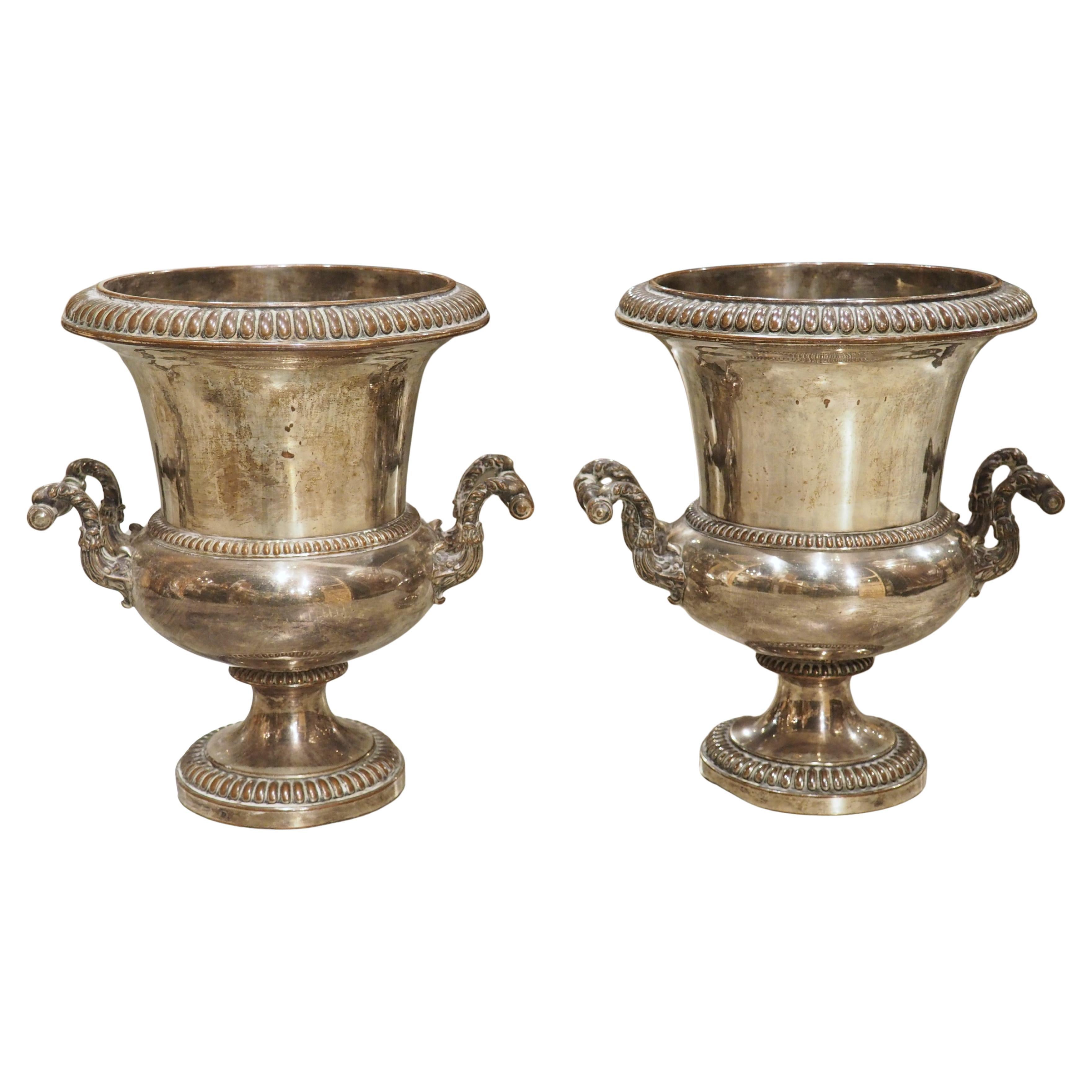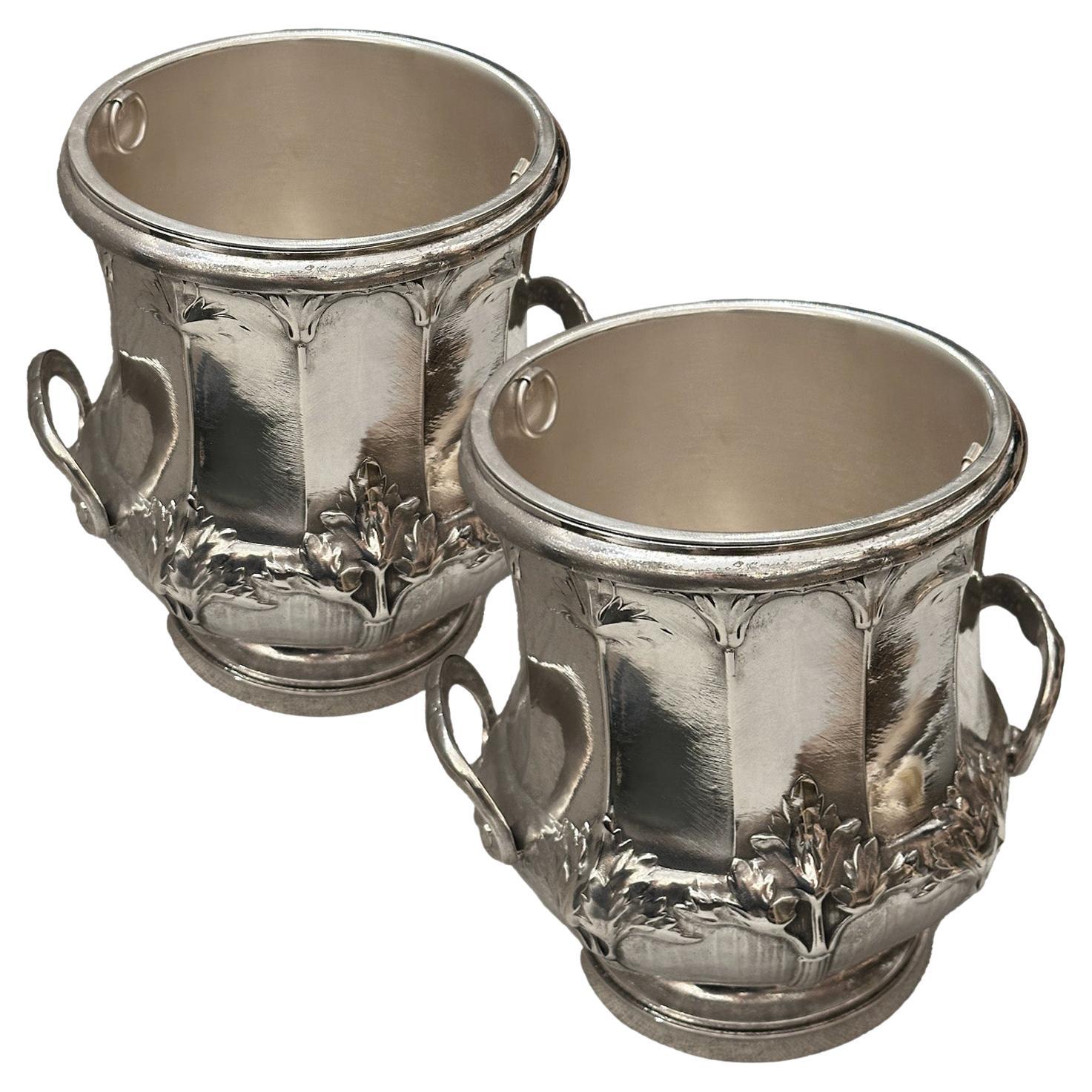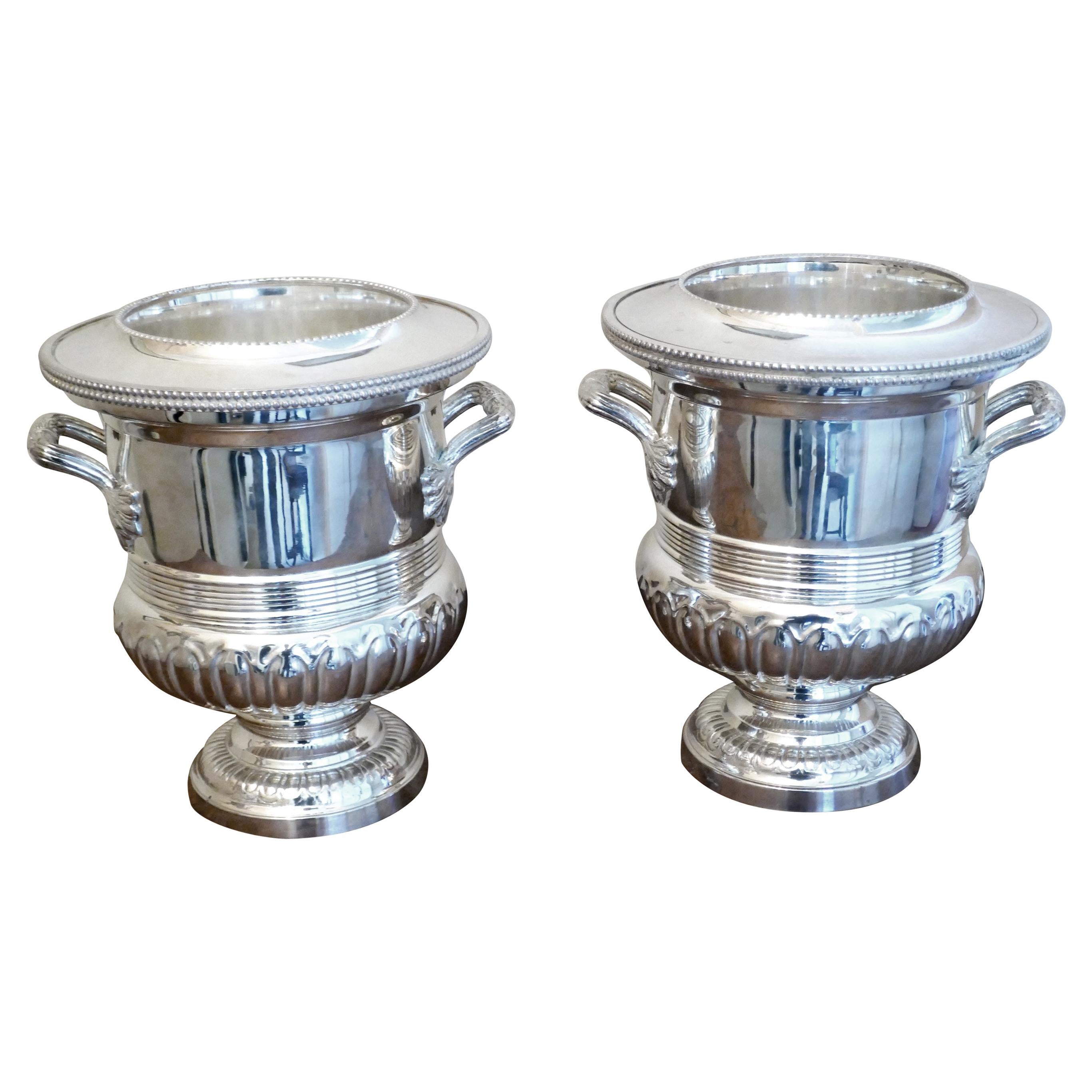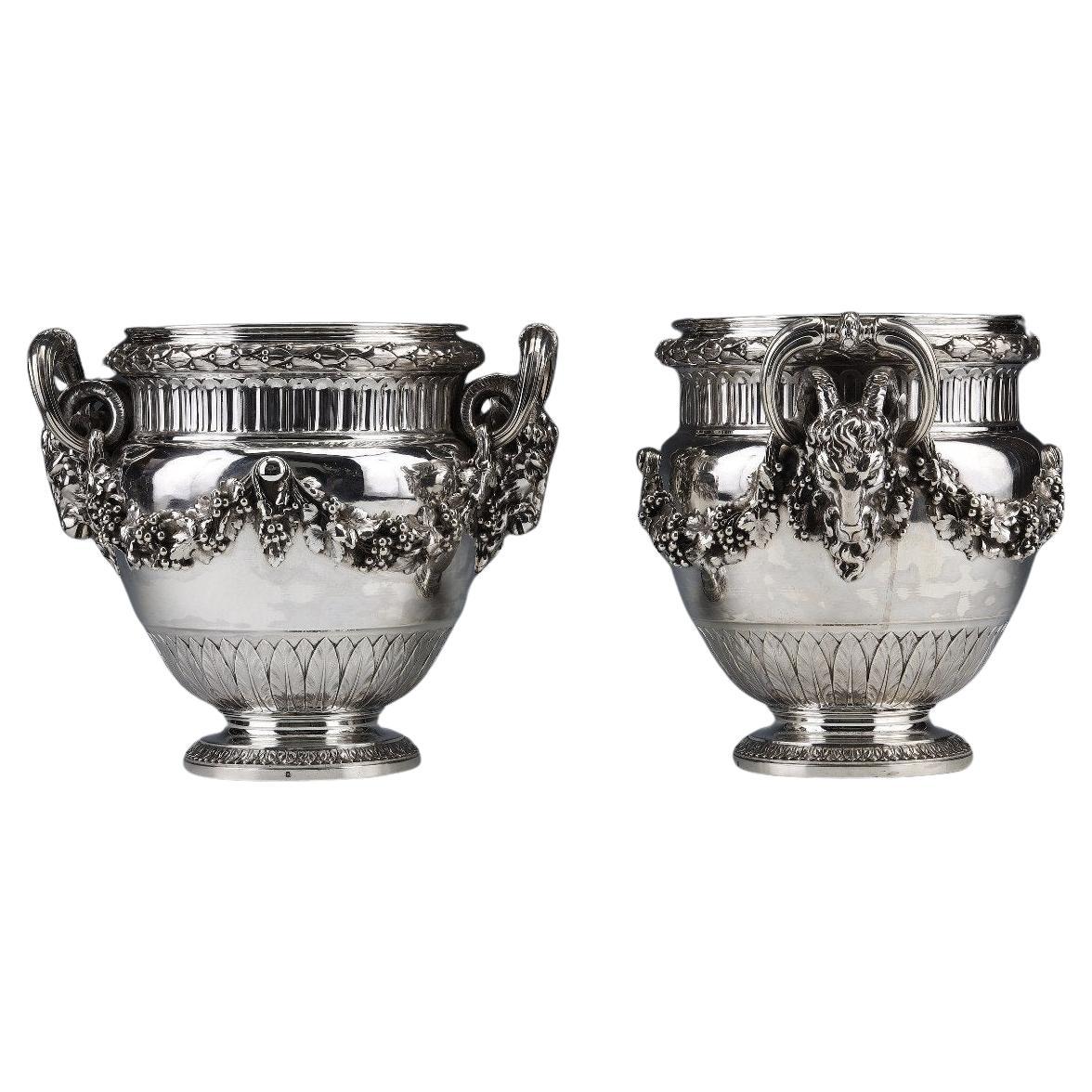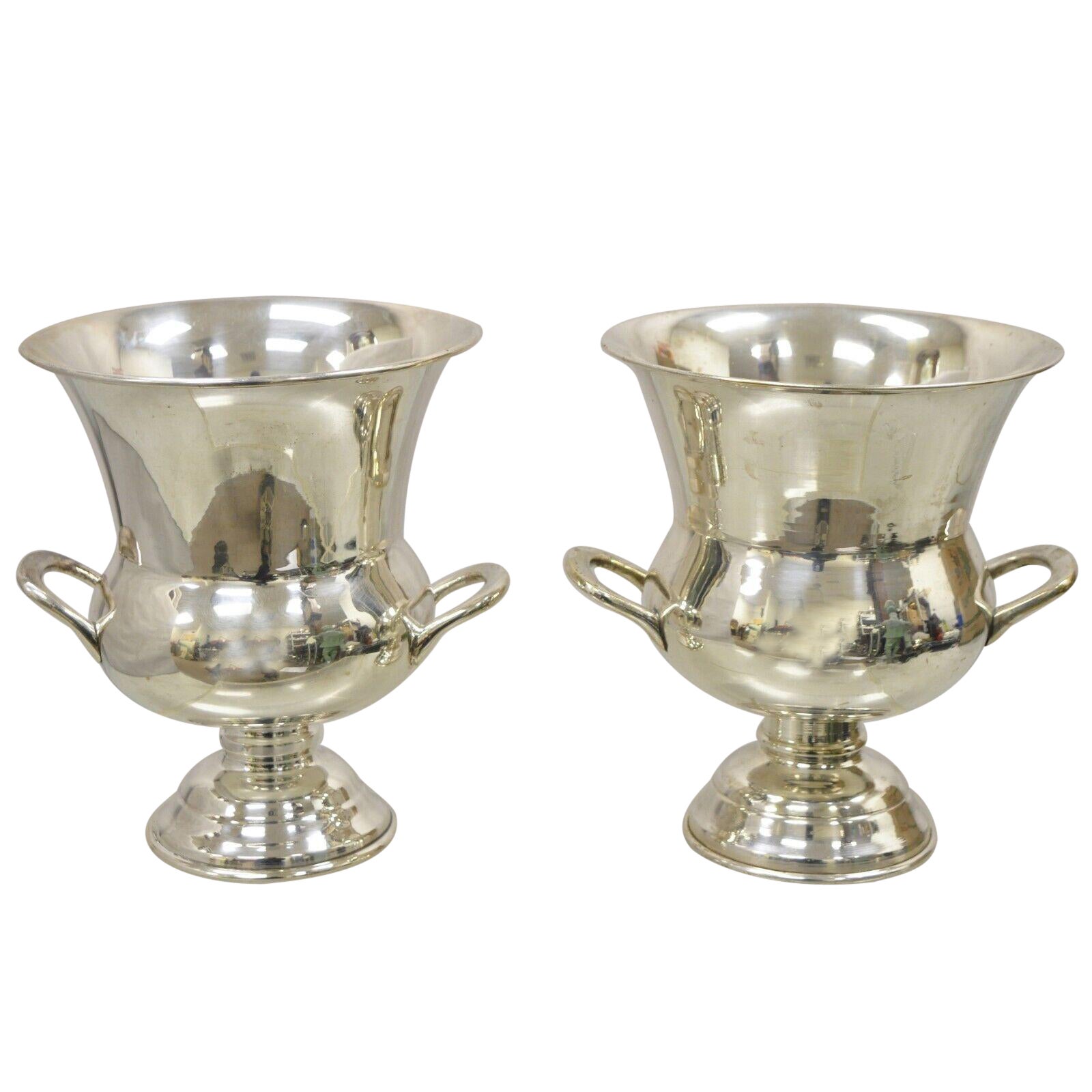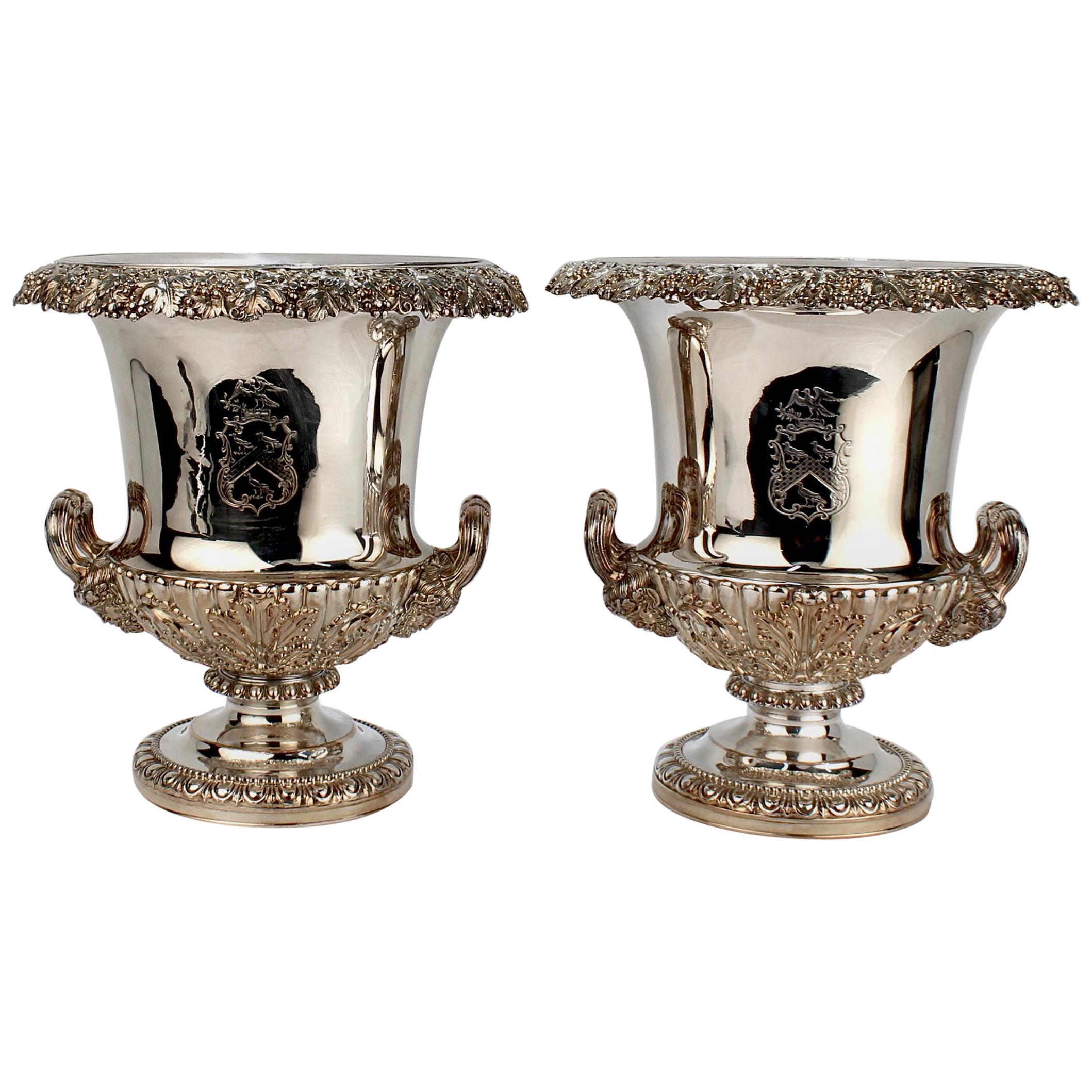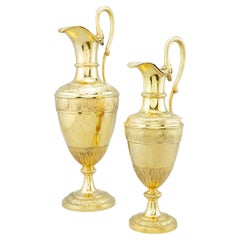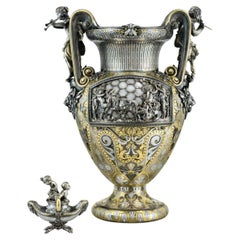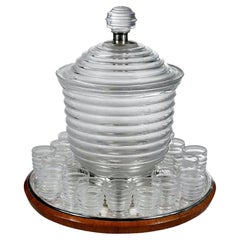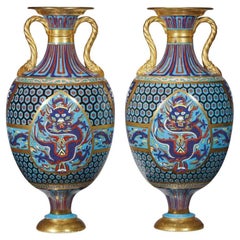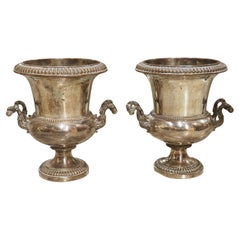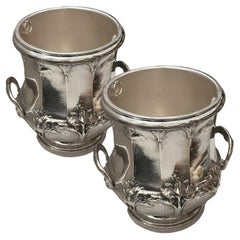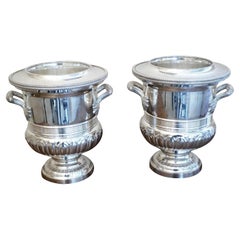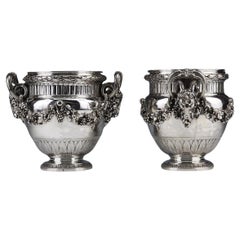Items Similar to Champagne Buckets in Sheffield Plate from George IV Period - Circa 1825
Want more images or videos?
Request additional images or videos from the seller
1 of 20
Champagne Buckets in Sheffield Plate from George IV Period - Circa 1825
$42,500
£32,073.58
€36,719.40
CA$59,939.09
A$65,805.65
CHF 34,330.95
MX$796,339.93
NOK 430,285.12
SEK 405,441.71
DKK 274,100.53
About the Item
Our George IV period Sheffield plate vases (circa 1820-1830) measure 25 in (63.5 cm) tall and feature stepped bases with applied grapevine borders with foliage below a wide band of grapevine with handles and rims of the removable liners formed as scrolling flora and foliage. Liner of each carries a red painted inventory mark "AA 373" where the letters are joined in a pseudo monogram.
- Dimensions:Height: 25 in (63.5 cm)Width: 22 in (55.88 cm)Depth: 20 in (50.8 cm)
- Style:George IV (Of the Period)
- Materials and Techniques:
- Place of Origin:
- Period:
- Date of Manufacture:circa 1825
- Condition:Wear consistent with age and use. Silver plate is worn to base metal in spots, particularly on one side of the base of one bucket. There are slight bends to the liners, scratches, nicks and small dents to each.
- Seller Location:New York, US
- Reference Number:Seller: 0511stDibs: LU6079226521682
About the Seller
No Reviews Yet
Vetted Professional Seller
Every seller passes strict standards for authenticity and reliability
Established in 1990
1stDibs seller since 2021
- ShippingRetrieving quote...Shipping from: New York, US
- Return Policy
Authenticity Guarantee
In the unlikely event there’s an issue with an item’s authenticity, contact us within 1 year for a full refund. DetailsMoney-Back Guarantee
If your item is not as described, is damaged in transit, or does not arrive, contact us within 7 days for a full refund. Details24-Hour Cancellation
You have a 24-hour grace period in which to reconsider your purchase, with no questions asked.Vetted Professional Sellers
Our world-class sellers must adhere to strict standards for service and quality, maintaining the integrity of our listings.Price-Match Guarantee
If you find that a seller listed the same item for a lower price elsewhere, we’ll match it.Trusted Global Delivery
Our best-in-class carrier network provides specialized shipping options worldwide, including custom delivery.More From This Seller
View AllMatched Pair Antique Austrian Silver-Gilt Ewers Circa 1780s
Located in New York, US
Our pair of elegant silver-gilt ewers are attributed to the Austrian maker, Johann Georg Hann of Vienna, circa 1780-1800. Heights: 17 7/8 and 22 1/2 in; 45 a...
Category
Antique Late 18th Century Austrian Neoclassical Pitchers
Materials
Silver
Boucheron Parcel Gilt Silver Vase and Oil Lamp circa 1880
By Fréderic Boucheron
Located in New York, US
Our important parcel-gilt and patinated silver and glass-mounted vase and matching oil lamp were designed by Paul Legrand (1840-1910) and crafted by the silversmith, Charles Glachant, for Boucheron of Paris, circa 1878-1880. 21 in tall and 16.5 in wide (53.4 by 41.9 cm). 28.56 lbs, 457 oz, 14,210 g.
Provenance: presented to or purchased by Jean-Baptiste Pezon (1827-1897); acquired by a European private collector, perhaps on the death of Jean-Baptiste Pezon in 1897, by descent; acquired by YM Antiques, 2017.
This double walled vase has an amphora form, with body and foot with silver, gilt and patinated and stylized flowers, anthemions and sprays of cherries against an etched and matted ground pierced to reveal a gilt inner wall. The upper body is detachable via a slip-lock, and mounted on both sides with arched panels formed of hexagonal beveled glass tiles. One glass panel applied with bacchic infants taunting a rearing goat and the other side with infants feeding grapes to a lioness under a looming bust of a satyr. The patinated and gilt upswung loop bifurcated handles are mounted with fully modeled figures of Pan bearing a syrinx and thyrsus and a draped maenad playing two flutes, both above roaring lion heads, the rim inset with a slip-lock detachable gilt bowl etched with masks of various representations of Bacchus spaced by ribbons and trophies and with scrolling fruiting vines. The base of interior with detachable base metal drip pan to accommodate the removable oil lamp designed to illuminate the glass tiles from within. The lamp is raised on four hoof feet, the upturned ends cast underneath with masks and with detachable cover mounted with two infant satyrs and flanked by gilt loop handles.
The bacchic themed design featuring cartouches depicting infants taunting a goat and lion, plus prominent lion masks at the handles, certainly appealed to Boucheron's customer, Jean-Baptiste Pezon (1827-1897), who is believed to have commissioned the piece. Pezon was the celebrated lion tamer and headliner of the Grande Menagerie whose profession brought him great fame and fortune in Paris. Born a shepherd boy in Lozere, he is said to have left his home at the age of seventeen in the company of a wolf he had captured and trained years earlier. He headed to Paris and by the age of twenty-one purchased his first lion who he named Brutus. The animal is said to have inspired the Lion of Belfort, the monumental red standstone sculpture by Frederic Bartholdi erected in Belfort in 1880. Toulouse-Lautrec was among his admirers and friends, visiting Pezon's Great Lozerian Menagerie to sketch animals. A large bronze sculpture of Pezon atop a female lion adorns the Pezon family tomb in the Pere Lachaise Cemetery in Paris, as seen in our image here.
The vase and detachable bowl are marked on the underside with the silversmith's mark of Charles Glachant. The underside and upper rim of the lower body is engraved "Fic Boucheron Paris". The lamp is marked on underside and flange of cover for Glachant.
Boucheron archives indicate the vase was inspired by the amphora vases created by the Greek potter, Nikosthenes, 550-510 BC. The Nikosthenic amphora vases are a form of Attic vase recognized for their angular amphora form with broad flat handles. Potted of bright orange-red clay, they were decorated with plant and animal motifs within distinct friezes, with the most significant defining feature being the black figure painting, often highlighted with white accents. In this vase Legrand re-imagines the striking contrast of the black figures against a warm ground through the use of patina and gilding. His inventive use of piercing and double-wall construction create additional levels of texture and depth throughout the body. The same combination of ornamentation was employed in a ewer designed by Legrand in 1880 in the Islamic taste. (See lot 77 of Christie's sale in New York on October 22, 2009.)
Edmé Bouchardon (1698-1762), royal sculptor to Louis XV, may have provided Legrand with inspiration for the vase's iconography. The panel featuring bacchic infants taunting a rearing goat is very similar to a bas relief representation of Winter designed by Bouchardon for the Fontaine des Quarte-Saisons on rue de Grenelle, Paris. Bouchardon debuted his plaster model for the bas relief in 1741, and the fountain was completed in 1745.
The Boucheron firm, founded by the celebrated jeweler, Frédéric Boucheron...
Category
Antique 1880s French Greek Revival Vases
Materials
Silver
German Art Deco Punch Bowl Set
Located in New York, US
Our set by Wilhelm von Eiff (1890–1943) includes a large bowl with frosted and carved horizontal bands with domed lid with silver mount, 17 3/4 by 12 1/2 inches, finial showing a young Hercules wrestling a serpent, ladle with Hercules cameo in .800 silver, signed W.V. Eiff, a glass ladle...
Category
Early 20th Century German Art Deco Serving Bowls
Materials
Silver
Christopher Dresser Faux Cloisonne Vases for Mintons
By Minton
Located in New York, US
Our exceptional pair of enameled porcelain vases in the Chinese cloisonné style were designed by Christopher Dresser (1834-1904) for Mintons.
They feature one side with a dragon an...
Category
Antique Late 19th Century British Chinoiserie Vases
Materials
Porcelain
Antique Patinated Bronze Hydria Water Jar After the Ancient Neopolitan
Located in New York, US
Our antique Grand Tour bronze hydria water jar after the original Greek design, circa 5th century BC, has a verdigris green patina and is finely cast with a winged laughing mask and ...
Category
Antique Late 19th Century Italian Neoclassical Revival Jars
Materials
Bronze
Persian Ware Ceramic Bottle Vases Attributed to Samson et Cie
By Samson & Cie
Located in New York, US
Our pair of Persian ware ceramic bottle vases in the 17th century Iznik style, attributed to Samson et Cie, circa 1870-1890, are decorated with the figure...
Category
Antique Late 19th Century French Vases
Materials
Pottery
You May Also Like
Pair of Antique French Silver Plated Champagne Buckets, Paris, 19th Century
Located in Dallas, TX
More information coming soon…
These two campana form champagne buckets from the 1800s have silver plating, with a wonderful golden patina to some exposed areas. From France, the be...
Category
Antique 19th Century French Wine Coolers
Materials
Metal
French Art Nouveau Silver Champagne Buckets Parisian 19th-Century
Located in Paris, FR
Pair of silver-plated champagne buckets dating from the late 19th century, signed by Maison Argit, silversmiths specializing in tableware. Each bucket stands on an elegant pedestal b...
Category
Antique 19th Century French Wine Coolers
Materials
Silver Plate
Fine Pair of Campana Style Wine Coolers, Champagne Ice Buckets
Located in Godshill, Isle of Wight
A fine pair of Campana style wine coolers, champagne ice buckets
A very attractive pair of vintage ice buckets complete with removable interior liners
The wine coolers are in hea...
Category
Vintage 1950s George III Wine Coolers
Boin Taburet - Pair Of Solid Silver Wine Coolers Louis XVI - 19th Century
By Boin-Taburet
Located in SAINT-OUEN-SUR-SEINE, FR
Pair of solid silver coolers mounted on a pedestal, engraved with a decoration of water leaves, halfway down a large garland of laurel leaves is connected to the handles represented ...
Category
Antique Late 19th Century French Louis XVI Sterling Silver
Materials
Silver
Vintage Leonard Silver Plated Trophy Cup Ice Bucket Champagne Chiller, a Pair
Located in Philadelphia, PA
Vintage Leonard Silver Plated Trophy Cup Ice Bucket Champagne Chiller - a Pair. Item features an original stamp, clean modernist lines, great styl...
Category
Mid-20th Century Regency Barware
Materials
Silver Plate
Antique Georgian Sheffield Plate Wine / Champagne Coolers, T & J Creswick, Pair
Located in Philadelphia, PA
A very fine pair of crested Georgian Sheffield Plate campagna-form wine coolers.
Made by T. & J. Creswick of Birmingham, England.
Each has an engraved armorial crest, reeded handle...
Category
Antique Early 19th Century British George III Barware
Materials
Sheffield Plate
$6,950 / set
Free Shipping
More Ways To Browse
Circa 1825
Antique Champagne Bucket
Blue Frosted Glass
Art Deco Pottery Glazed
1924 Furniture
Italian Bronze Vase
Lalique Frosted
Large Blue And White Chinese Vase
Danish Antique And Modern
Fine Porcelain Vase
Scandinavian Pewter
Tall Clear Vases
Art Nouveau Loetz Glass
Ceramic Modernist Vase
Cloisonne Brass
Orange Ceramic Italian
Lava Glaze Vase
Loetz Austria
